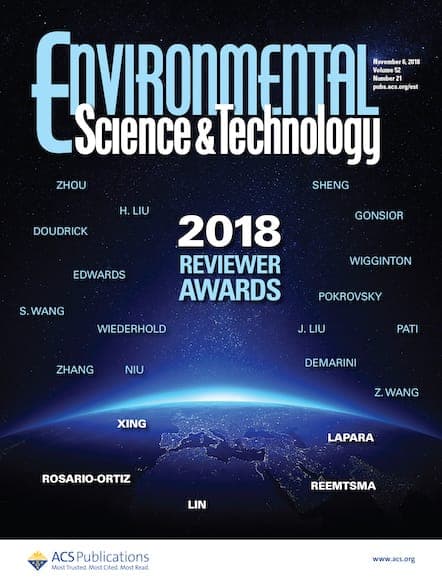Microplastics are becoming a ubiquitous ecological contaminant. Chemists in diverse fields are attempting to better understand the behavior of microplastics and develop novel solutions to limit their impact, both on human health and ecosystems.

The Scale of the Problem
Microplastics are defined as small plastic pieces and fragments less than 5 mm in length. These present a problem for wildlife, plants, and humans—and it is a problem that keeps growing. It is estimated that more than 3 million metric tons of microplastics enter the environment each year. These come from a variety of sources, from vehicle tires and road markings to clothing and cosmetics. As a result, the average person eats, drinks, or inhales up to 211,000 microplastic particles every year—or about 250 grams.1
Impact on Human Health
Several recent studies published in Environmental Science & Technology reveal various effects of microplastic pollution on the human body. One study analyzed phlegm samples from people with various lung diseases, and the researchers found microplastic accumulation in everyone tested. In total, 21 types of microplastics were identified; polyurethane was the dominant culprit, followed by polyester, chlorinated polyethylene, and alkyd varnish.2 Researchers in China have also revealed a positive correlation between the concentration of microplastics in fecal matter and severity of inflammatory bowel disease.3
Microplastic accumulation may also occur in our bodies before we are even aware of our own existence. A recent study has demonstrated the first evidence in humans of an association between microplastics and microbiota in placental and meconium samples—suggesting microplastics are altering human biology even before birth.4
What’s the Bigger Picture?
These tiny particles are an environmental disaster in their own right, but it is also becoming increasingly clear that they can carry other pollutants and contaminants on their surfaces. In fact, microplastics seem to have an unexpectedly high affinity for heavy metals, a trend that has been found in environmental samples worldwide. For example, researchers have demonstrated that UV filters from sunscreens can make chromium metal take on a different, more toxic oxidation state when attached to microplastics.5
This study provides the first evidence into how microplastics can turn heavy metals and pollutants into more harmful versions of themselves. As microplastics continue to accumulate in our bodies and in the environment, more comprehensive assessments are necessary to better understand the extent to which these complexes are affecting our health.
Assessing the Risk
Understanding microplastics’ long-term degradation behavior and environmental presence is essential for risk assessment and reporting. Part of this includes being able to differentiate size classes and degradation states over time. One study sets out a protocol to better assess microplastic degradation rates and quantify the release of micro- and nanoplastic fragments down to 10 nm.6 The researchers created a simulated beach environment to observe the effects of UV aging, hydrolysis, and mechanical stress on environmental degradation and fragmentation.
The results show that previously formed fragments can further degrade into water-soluble organics with measurable rates, which is promising for enabling future modeling approaches. The researchers report that further identification and risk assessment of these dissolved species will be important for future work, as well as assessing scenarios and stresses beyond UV degradation.
Learn More About Microplastics in ACS Journals
Biofilm Formation Influences the Wettability and Settling of Microplastics
Amber J. Pete, Philip J. Brahana, Mustapha Bello, Michael G. Benton, and Bhuvnesh Bharti
DOI: 10.1021/acs.estlett.2c00728
Recent Advances in Spectroscopic Techniques for the Analysis of Microplastics in Food
Xin Guo, Helen Lin, Shuping Xu, and Lili He
DOI: 10.1021/acs.jafc.1c06085
Using Adhesives to Capture Microplastics from Water
P. Takunda Chazovachii, Julie M. Rieland, Violet V. Sheffey, Timothy M. E. Jugovic, Paul M. Zimmerman, Omolola Eniola-Adefeso, Brian J. Love, and Anne J. McNeil
DOI: 10.1021/acsestengg.1c00272
Hitchhiking into the Deep: How Microplastic Particles are Exported through the Biological Carbon Pump in the North Atlantic Ocean
Luisa Galgani, Isabel Goßmann, Barbara Scholz-Böttcher, Xiangtao Jiang, Zhanfei Liu, Lindsay Scheidemann, Cathleen Schlundt, and Anja Engel
DOI: 10.1021/acs.est.2c04712
References
- https://www.statista.com/chart/18299/how-we-eat-drink-and-breathe-microplastics/
- Huang, S. et al. Detection and Analysis of Microplastics in Human Sputum. Environ. Sci. Technol. 2022, 56, 4, 2476–2486.
- Yan, Z. et al. Analysis of Microplastics in Human Feces Reveals a Correlation between Fecal Microplastics and Inflammatory Bowel Disease Status. Environ. Sci. Technol.2022, 56, 1, 414–421.
- Liu, S. et al. The Association Between Microplastics and Microbiota in Placentas and Meconium: The First Evidence in Humans. Environ. Sci. Technol. 2022, Article ASAP
- Ho, W-K. et al. Sorption Behavior, Speciation, and Toxicity of Microplastic-Bound Chromium in Multisolute Systems. Environ. Sci. Technol. Lett. 2023, 10, 1, 27–32.
- Pfohl, P. et al. Environmental Degradation of Microplastics: How to Measure Fragmentation Rates to Secondary Micro- and Nanoplastic Fragments and Dissociation into Dissolved Organics. Environ. Sci. Technol. 2022, 56, 16, 11323–11334.
